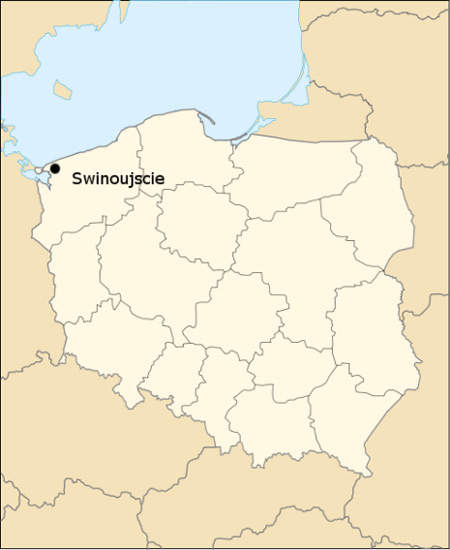
Poland has been in talks since 2006 with a number of LNG producers to allow it to diversify its gas supply and reduce its reliance on Russian gas provided by Gazprom.
Poland was caught up in a row between Russia and the Ukraine, which resulted in a reduction of gas supplies to Poland, Hungary and Austria. The Polish government was anxious to avoid a repeat of that situation, and built an LNG terminal and investigated the possibility of a pipeline from Norway, Ukraine, Denmark or Germany.
Strategic location
The terminal was constructed at Swinoujscie near Szczecin in the western part of Poland’s Baltic coast (West Pomeranian region).
The advantages of this placement include the lower costs to receive big ships and freight compared with those in Gdansk, and there are large gas consumers (power station and chemical plant) in the immediate vicinity.
A funding of approximately €950m was secured for Poland’s first LNG project in March 2010. Construction of the terminal was completed in October 2015, and it received its operating permit in April 2016.
Swinoujscie annual demand
Poland’s annual demand for gas was around 16.4 billion cubic metres in 2009. Domestic production accounted for five billion cubic metres (30%) at that time, with the remainder provided by Russian imports.
The new Nord Stream line from Russia to Germany (missing out Poland) is expected to have an effect on the amount of gas available for Poland from Russia.
Poland has been nervous about Russian gas. Gaz de France (GDF) previously expressed an interest in helping Poland to build and establish an LNG terminal.
GDF agreed to supply 10.27 billion cubic metres of gas a year to Poland from 2022 to 2037 under an agreement signed in November 2009. However, the contract will be valid only after the required documents between the governments of Poland and Russia are signed.
Contractors involved with the Polish LNG terminal
Canadian LNG engineering specialist SNC-Lavalin was chosen by the Polish natural gas distributor Polskie Gornictwo Naftowe i Gazownictwo (PGNiG) to perform the front-end engineering and design (FEED) for Poland’s first LNG import terminal in January 2008, following a long consultation period.
The site chosen for the new facility was on the Baltic coast at Swinoujscie. The FEED contract is worth zlotyl26m (C$10.6m, €7.2m). SNC-Lavalin was chosen as the preferred contractor over five other bidders in the tender process that also included Suez-Tractebel of France.
The engineering, procurement and construction (EPC) contract for the project was awarded to a consortium of Saipem (SPM.MI) of Italy, Saipem of France, Italy’s Techint Compagnia Tecnica Internazionale, Snamprogetti of Canada, PBG of Poland and PBG Export of Poland. The consortium was led by Saipem.
The value of the contract was PLN2.95bn ($930m), and construction started on the project in 2011.
Intertek was awarded a contract to provide custody transfer inspection services at the terminal.
MałkowskiMartech secured a contract to equip windows, doors and fire-proof protections in June 2013.
Technical aspects
The Polish gas distributor PGNiG hoped to complete construction of the new terminal and bring it onstream by June 2014, but the project was delayed.
The new terminal is expected to initially receive 5 billion cubic metres of liquefied gas a year as part of the Polish strategy to limit its dependence on imports from Russia. It is, however, designed to deliver up to five billion m³ of gas a year.
The LNG terminal is fully equipped with an unloading jetty with mooring system for unloading of large LNG tankers (with a boil-off and recondensing facility), two cryogenic containers of 160,000m³ each for storing in-process LNG, and regasification train to produce gas at the correct pressure for the grid.
An 85km-long pipeline from Świnoujście to Szczecin was also built, connecting the LNG terminal with the Polish transmission system.
Financing and expansion
The capacity will be enhanced in subsequent expansion phases of the project to 7.5 billion cubic metres, depending on demand.
The cost of the project was estimated to be around €350m to €450m based on current prices of materials, however this increased by €500m to reach €950m.
Out of the total cost of €950m, €200m was provided by European Bank for Reconstruction and Development. The remaining €750m was arranged by purchase of €75m of Polskie LNG bonds by each of ten other banks led by Bank Pekao and PKO Bank Polski.



